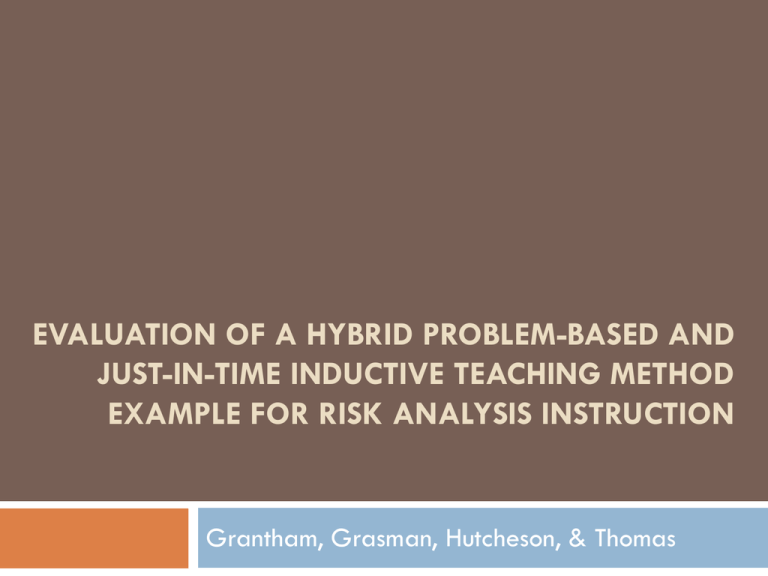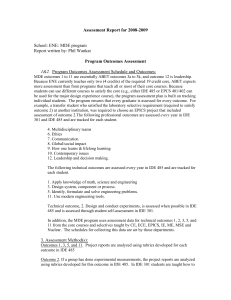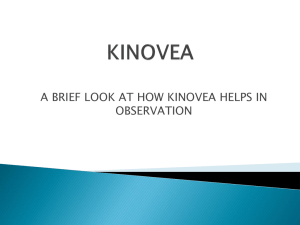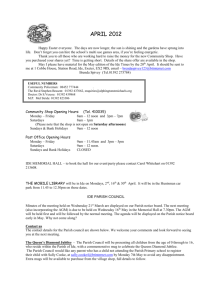Evaluation of a Hybrid Problem-Based and Just-in
advertisement

EVALUATION OF A HYBRID PROBLEM-BASED AND JUST-IN-TIME INDUCTIVE TEACHING METHOD EXAMPLE FOR RISK ANALYSIS INSTRUCTION Grantham, Grasman, Hutcheson, & Thomas Why Risk Education? Overview Project Introduction Risk Case Study Project Plan Risk Case Study Project Progress IDE 20 – Engineering (Product) Design IDE 120 – Materials Testing Laboratory EMGT 137 - Engineering Economy Future Work Project Introduction Goal Test the hypothesis that expert knowledge can be leveraged to promote undergraduate risk analysis instruction. Motivation Current undergraduate engineering instruction does not actively promote the understanding of potential risks inherent in every engineering discipline. Students unprepared to prevent disasters upon graduation, yet are often given tremendous responsibilities. Risk Case Study Project Plan It is often thought that EXPERIENCE is a requirement to performing a high quality risk assessment. Use the Risk in Early Design (RED) theory to provide EXPERIENCE to the students Just-in-time to educate them on Risk Identification and Assessment. Risk Case Study Project Plan Develop “How to” training materials for the RED theory Develop/Deploy 3 Case Studies Product Design – IDE 20 Materials Testing Laboratory – IDE 120 400 Students/year Engineering Economics-EMGT 137 1200 Students/year 600 Students/year Assess Case Study Effectiveness and RED tool effectiveness Risk Case Study Project Progress RED Instructional Materials Available in Google Sites Fall 2011 it was tested and evaluated by 22 students https://sites.google.com/a/mst.edu/red-workshop/ Survey Development Student survey is now developed for students who did the case studies assignments as part a class. Not yet deployed Risk Case Study Project Progress Product Design Case Study CASE: Cordless Drill Direction Selector Failure Deployed in both Fall 2011 & Spring 2012 Control group: http://ide20.com/?page_id=693 Group using RED: http://ide20.com/?page_id=712 Null Hypothesis for ANOVA: Expert knowledge obtained from the RED tool does not significantly increase a team’s ability to isolate and diagnose the failure mode considered in the experiment IDE20 Risk/Failure Case Study Students are first tasked with identifying the functionality of specific components of the drill’s power control assembly Power control Assembly IDE20 Risk/Failure Case Study They must then identify likely failure modes by using an FMECA approach (control) or FMECA+RED (experimental) approach with a common worksheet Worksheet Measures recorded % teams in a lab section that correctly identified the actual failure mode % teams in a lab section that identified the correct, or other plausible failure mode % of teams that selected the actual failure as a top 3 % of teams that selected the actual failure or other plausible failure mode as a top 3 IDE20 Risk/Failure Case Study Results were generated using a standard t-test Measures % teams in a lab section that correctly identified the actual failure mode % teams in a lab section that identified the correct, or other plausible failure mode % of teams that selected the actual failure as a top 3 % of teams that selected the actual failure or other plausible failure mode as a top 3 Significant (p=0.047) +15.6% Not significant (p=0.098) Not significant (p=0.113) Not significant (p=0.387) IDE20 Risk/Failure Case Study Correct Identification of Functionality Component % correct % plausible Sum Battery Connection 54.4% 40.8% 95.2% Switch/control Assm. 32.8% 28.8% 61.6% Reverser Switch 24.8% 22.4% 47.2% Trigger Switch 25.7% 56.7% 82.3% Motor Connection 10.4% 56.0% 66.4% Speed Control Trans. 85.6% 1.6% 87.2% Heat Sink 61.7% 29.5% 91.2% IDE20 Risk/Failure Case Study Correct Identification of Functionality Component % correct % plausible Sum Battery Connection Students Switch/control Assm. misunderstood the context of the Reverser Switch assembly Trigger Switch 54.4% 40.8% 95.2% 32.8% 28.8% 61.6% 24.8% 22.4% 47.2% 25.7% 56.7% 82.3% Motor Connection 10.4% 56.0% 66.4% Speed Control Trans. 85.6% 1.6% 87.2% Heat Sink 61.7% 29.5% 91.2% IDE20 Risk/Failure Case Study Correct Identification of Functionality Component % correct % plausible Sum Battery Connection 54.4% 40.8% 95.2% Switch/control Assm. 32.8% 28.8% 61.6% Reverser Switch 24.8% 22.4% 47.2% Trigger Switch Students selected Motor Connection non-conservative transformations Speed Control Trans. (energy Heat Sink to signal) 25.7% 56.7% 82.3% 10.4% 56.0% 66.4% 85.6% 1.6% 87.2% 61.7% 29.5% 91.2% Risk Case Study Project Progress Conclusions Fall 2011 experiment was highly successful (126 teams) Most teams completed the study during class time Data was easily collected and processed One significant result was found Spring 2012 experiment will be identical Data will be added to the FS2011 set Semester blocking effect will be analyzed Hypothesis currently support by data FMECA+RED significantly increased (+15.6%) a team’s ability to isolate and diagnose the exact failure mode considered in the experiment A conference paper has been submitted to ASME IDETC2012 Risk Case Study Project Progress Materials Testing Laboratory Case Study CASE: Reverse Case Study Development Status: Deployed Synopsis: Students will be given broken samples and given the evidence provided to them, they must create a plausible case study to explain what led to the broken item. Materials Testing Laboratory Materials Testing Laboratory Materials Testing Laboratory Materials Testing Laboratory Materials Testing Laboratory Risk Case Study Project Progress Materials Testing Laboratory Case Study CASE: Reverse Case Study Development Status: Deployed Synopsis: Student teams choose three broken items, identify failure modes, and write a creative story that combines all three failures. IDE 120 Reverse Case Study IDE 120 Reverse Case Study IDE 120 Reverse Case Study IDE 120 Reverse Case Study IDE 120 Reverse Case Study IDE 120 Reverse Case Study Results 36 ?? of 52 items chosen 33% bowling ball, 25% highway sign, 19% racquet, 19% transmission cluster, 17% Corvette steering mechanism correctly identified failure mode 36% impact, 24% rupture, 15% fatigue, 7% creep 25% impact fracture, 15% brittle fracture, 10% high cycle fatigue, 8% ductile rupture, 8% impact deformation only 19% revised decisions upon reflection 6% picked new items just to help narrative 26% used class terminology instead of failure taxonomy creative writing IDE 120 Reverse Case Study IDE 120 Reverse Case Study IDE 120 Reverse Case Study Timeline F10-W11: 17 items, Control vs RED (33/34 teams) S11-F11: improved Google Analytics approach W12: 52 items, RCS (49 teams) S12: additional functional models F12: 52 items, RCS+RED ????: 100 items Business Risk Case Study Engineering Economics (Eng. Mgmt. 137) Case Study CASE: LED Luminaire Technology Status: To be deployed April 2012, 250 students Synopsis: LED luminaire technology is of increasing interest for roadway lighting solutions to state DOTs and local communities due to proposed benefits in fiscal and environmental stewardship, as well as safety and useful life. The case will detail the implications of LED technology across the three pillars of sustainability (economic, environmental, and social) and provide opportunities for economic and business risk analysis by student teams. Business Risk Case Study High Pressure Sodium Students will analyze current data and report: • • • • Results of a systematic economic analysis Assessment of environmental impact Potential business and economic risks Recommended action – high pressure sodium or LED luminaires LED Luminaires Future Work – Spring 2012 Publish 3 Case Studies Publish Results of Teaching Method Testing QUESTIONS?











